Sprinkler Irrigation: [Advantages, Disadvantages, Forms and Operation]
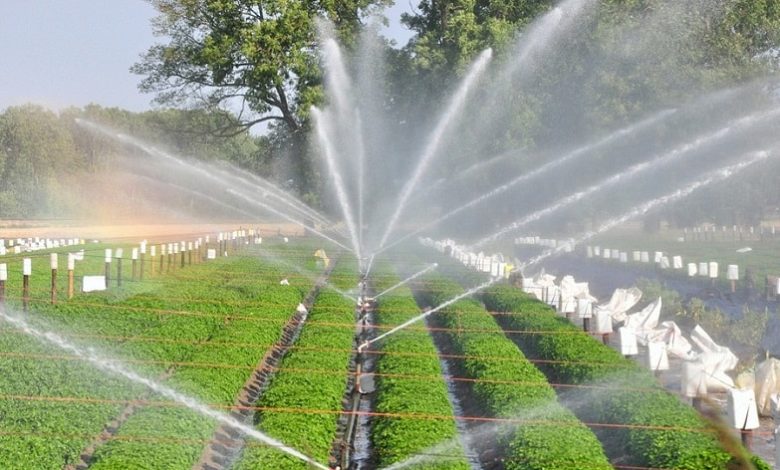
 Sprinkler irrigation (also known as water sprinkler or simply sprinkler) is a form of irrigation used to irrigate agricultural crops, lawns, landscapes, golf courses, and other areas.
Sprinkler irrigation (also known as water sprinkler or simply sprinkler) is a form of irrigation used to irrigate agricultural crops, lawns, landscapes, golf courses, and other areas.
Spray hazard is also used for cooling and airborne dust control.
Sprinkler irrigation is the method of applying water in a controlled manner similar to rain.
Water is distributed through a network that may consist of pumps, valves, pipes, and sprinkler heads.
Irrigation sprinklers can be used for residential, industrial and agricultural use. It is useful on uneven terrain where there is not enough water, as well as on sandy soil.
| Advantage | Disadvantages |
| Eliminates water conduction channels, thus reducing possible losses in water transport. | It is easier to waste water if the installation is not correct. |
| Suitable on all types of soils, except clay. | Weeds proliferate more easily. |
| Helps increase performance. | Installation can be more expensive and may require more technical knowledge. |
| Simulate irrigation as if it were rain. | Its efficiency depends a lot on the strength with which the wind blows. |
| Reduces soil compaction. |
Perpendicular tubes, which have rotating nozzles at the top, join the main pipe at regular intervals. When the water is pressurized through the main pipe, it escapes from the rotating nozzles. It is sprayed on the crop.
In sprinkler or overhead irrigation, water is directed to a more central location within the field and distributed by high-pressure overhead sprinklers or cannons.
What is sprinkler irrigation?
The sprinkler irrigation system allows the application of high pressure water with the help of a pump. It releases the water in a similar way to rain through a small diameter nozzle placed in the pipes.
The water is distributed through a pipe system, sprayed into the air and irrigated on most types of soil thanks to the wide range of discharge capacity.
Sprinkler irrigation consists of applying water to the soil simulating rain.
This effect is achieved thanks to the pressure in which the water flows within a piping system and is expelled to the outside through the nozzles of a sprinkler. Normally, the required pressure is obtained from hydraulic pumps which draw water from a canal, river or well.
However, the system can also operate without pumps when the water source is in a higher position than the land to be irrigated.
What are the advantages of the sprinkler irrigation system?
- Eliminates water conduction channels, thus reducing possible losses in water transport.
- Suitable on all types of soils, except clay.
- Suitable for irrigation when the population of plants per unit area is very high.
- Helps increase performance.
- Simulate irrigation as if it were rain.
- Reduces soil compaction.
- The mobility of the system facilitates its operation.
- Suitable for undulating terrain.
- Saves land, since no barriers are needed.
- The use of fertilizers and soluble chemicals is possible.
- Provides frost protection and helps alter the microclimate.
- Reduces the cost of labor.
What disadvantages does this system have?
- The much easier to waste water than with other irrigation systems if not installed correctly.
- If you do not have weed control systems, they proliferate much more than, for example, with other systems, such as drip irrigation.
- It can be more difficult to install and also to maintain.
- It is sensitive to wind. Windy days can affect irrigation.
What do we need to start up a sprinkler irrigation system?
the sprinklers
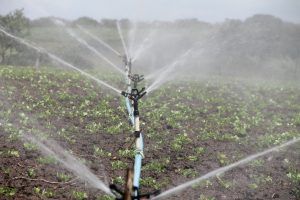
Sprinklers are the most important element in water irrigation equipment.
They are devices that spray water in several droplets. The water is evenly distributed on the ground.
Due to the rotation of the sprinkler body, the reaction effect of the sprinkler pulse The jet of the hammer arm returns to its original position by the action of the hammer.
The flow rate of the sprinkler will be determined by the diameter of the nozzle and its pressure.
For example:A sprinkler designed to provide a flow rate of 1200 l/h at a pressure of 2 kg/cm2.
When the pressure drops, it will reduce less flow, and when the pressure drops, it will reduce more flow.
The range of the sprinkler head that determines the spray radius depends on the angle of inclination of the nozzle and the working pressure.
The maximum wetting radius can be obtained when the angle of inclination is 45º, if the wind is not important this value should be selected. However, in windy conditions, low angle sprinklers should be selected, and sprinklers with an angle of attack between 25 and 25 degrees are most recommended. 27.
- Sprinkler spray: This parameter depends on the diameter of the nozzle. For a given nozzle diameter, when the working pressure is lower, the droplet size is larger. For a given working pressure, the size of the droplet increases as the diameter of the nozzle increases.
- Pluviometry: Indicates the intensity of sprinkler irrigation and is measured by the height of the water received on the ground in a given time. It is normally expressed in mm/h. As a design criterion, the sprinkler rainfall should be equal to or slightly less than the basic permeability of the soil to prevent runoff.
pump unit
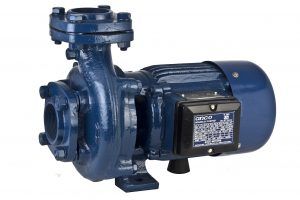
The sprinkler irrigation system water pump is a device with the following functions: Mechanical lifting equipment whose purpose is to absorb water from a water source. Select it and push it into the pipe network. The pump unit may have the following components:
- suction chamber.
- Electric bomb.
- Basket valve and suction valve.
- Accessories and exhaust accessories.
- Suction pipe.
Electric bomb
A motorized pump is a device made up of a motor and a pump.
The mechanical energy of the motor produces the activation of the pump, in charge of sucking the water towards the pipes with a certain pressure and flow. This is due to the centrifugal force generated by the engine power and the design of the boost engine.
The electric pump is the main part of the pumping unit and must Before proceeding with the installation, select the correct one. equipment
Choose the electric pump according to the required water flow, height, overall geometry and the pressure required for the water outlet (sprinkler head).
Distribution network
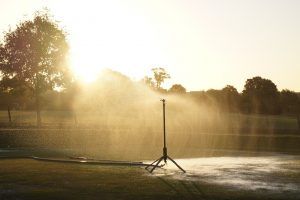
The distribution network must be understood as a set of pipes that constitute the main network and the auxiliary lines or lateral branches.
The main network is a pipe that leads pressurized water from the pump to the lateral branches, and these branches are led from the main network to the nozzles installed in the branches.
What factors affect sprinkler irrigation?
There are a number of factors that directly or indirectly affect our sprinkler irrigation systems.
flow pressure
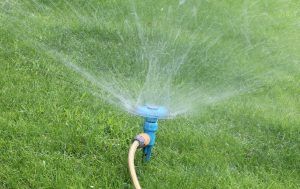
The working pressure of the sprinklers is probably the most important element. Therefore, it is important to determine if our sprinkler heads are working properly.
When the pressure is low, the water is broken into large droplets and therefore their distribution is not correct. If the sprinkler has adequate pressure it will produce a uniform and correct moisture pattern.
Wind speed
Another important factor is the wind. To avoid this factor, it is very important to distribute the sprinklers correctly and give them enough distance.
The higher the altitude, the higher the wind speed and therefore more affected by this factor. The sprinkler design should be installed as low as possible.
Usual speeds of more than 2.5 m/s mean that sprinkler irrigation is NOT recommended. While speeds between 1 and 2.5 m/s do not recommend it.
Types of sprinkler irrigation
Industrial sprinkler irrigation
Higher pressure sprinklers that move on their own in a circle are driven by a ball, gear, or impact drive mechanism (impact sprinklers). They may be designed to rotate in a full or partial circle.
Guns are similar to impact sprinklers, except that they generally operate at very high pressures, from 40 to 130 lbf/in² (275 to 900 kPa) and flow rates from 50 to 1,200 gal/min (3 to 76 L/s), normally with nozzle diameters of the order of 10 to 50 mm.
In addition to irrigation, cannons are used for industrial applications such as dust suppression and logging.
Many irrigation sprinklers are buried in the ground along with their supporting pipes, although above-ground and mobile sprinklers are also common.
Most irrigation sprinklers work using electrical and hydraulic technology and are grouped into zones that can be switched on and off collectively by actuating a solenoid valve.
Residential Sprinkler Irrigation
An oscillating sprinkler is commonly used to water residential lawns, and it moves as needed.
Home lawn sprinklers vary widely in size, cost, and complexity. They include impact sprinklers, oscillating sprinklers, drip sprinklers, underground sprinkler systems, and portable sprinklers.
Permanently installed systems often work with timers or other automated processes. They are sometimes installed with retractable heads for aesthetic and practical reasons, reducing damage during mowing.
These types of systems can often be scheduled to automatically start up at a set time and day each week.
Small portable sprinklers can be placed temporarily in the lawn if additional watering is needed or a permanent system is not available. They are often connected to an outside water tap and placed for a short period of time.
Other systems can be professionally installed permanently in the ground and permanently connected to a home’s plumbing system.
In the 1950s an early sprinkler developed by Nomad, called a » fix and forget tractor sprinkler «, was used in Australia. The water pressure caused the sprinkler to move slowly across the lawn.
Sprinkler irrigation in agriculture
The earliest use of sprinklers by farmers was in a form of home and golf course type sprinklers.
These ad hoc systems, while doing the work of buried pipes and fixed sprinklers, interfered with cultivation and were expensive to maintain. Center pivot irrigation was invented in 1940 by farmer Frank Zybach, who lived in Strasburg, Colorado.
In the 1950s, Stout-Wyss Irrigation System, a company based in Portland, Oregon, developed a pipe-type farm irrigation system that has become the most popular form of irrigation for farmers irrigating large fields..
With this system, large wheels attached to large pipes with sprinklers move slowly across the field.
Sources and references
- https://www.sciencedirect.com/topics/agricultural-and-biological-sciences/sprinkler-irrigation
- https://en.wikipedia.org/wiki/Irrigation_sprinkler
- https://agritech.tnau.ac.in/agricultural_engineering/spring_irrigation.pdf
- https://christieslandscapes.com.au/complete-low-cost-guide-to-maintaining-a-sprinkler-irrigation-system/
- https://biblioteca.inia.cl/bitstream/handle/123456789/40180/NR26419.pdf?sequence=1&isAllowed=y
- http://oa.upm.es/19378/1/INVE_MEM_2012_140545.pdf


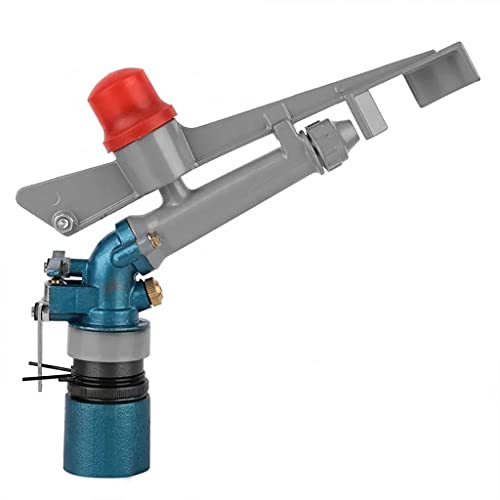
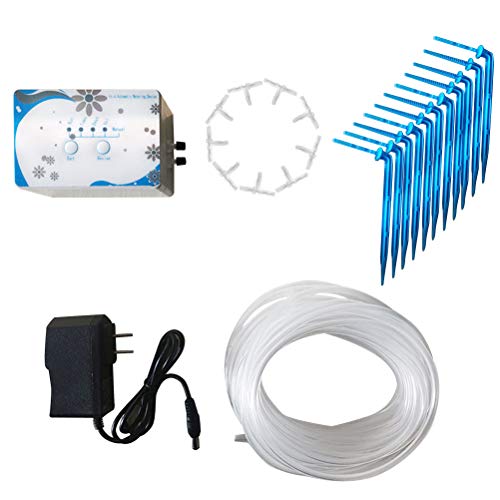

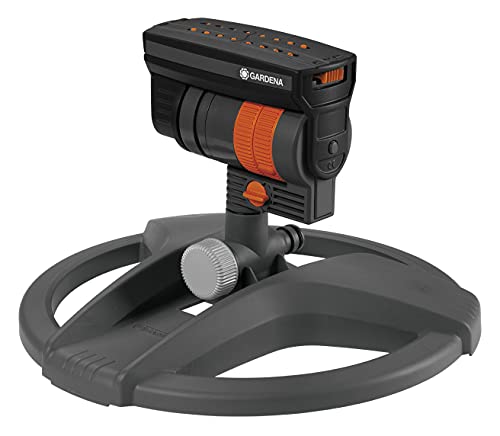
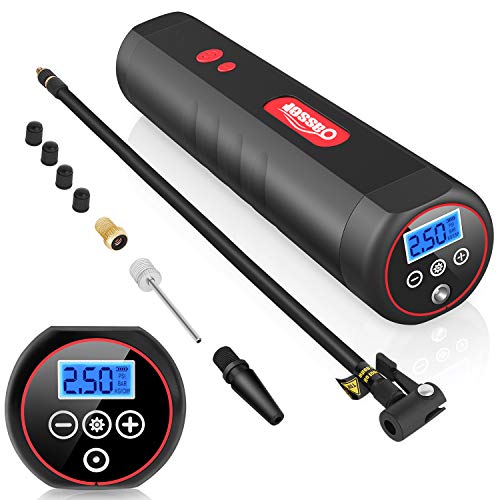






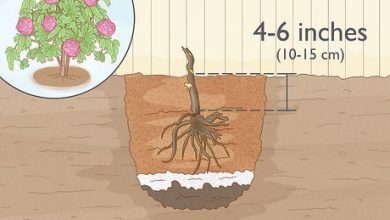
![Photo of Tradescantia Pallida or Purpurina: [Sowing, Care, Irrigation and Substrate]](https://www.complete-gardening.com/wp-content/uploads/2021/06/Tradescantia_pallida_1568322704-390x220.jpg)
![Photo of Deciduous Forest: [Concept, Characteristics, Fauna and Flora]](https://www.complete-gardening.com/wp-content/uploads/2022/08/deciduous-forest-concept-characteristics-fauna-and-flora-390x220.jpg)